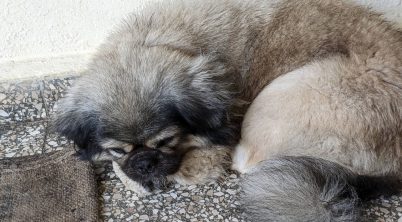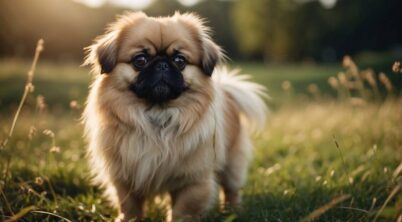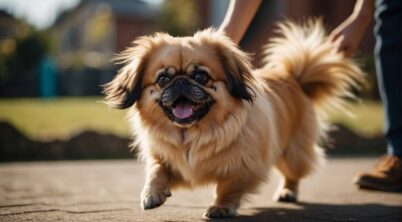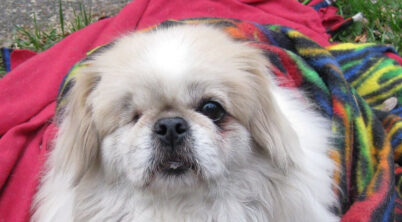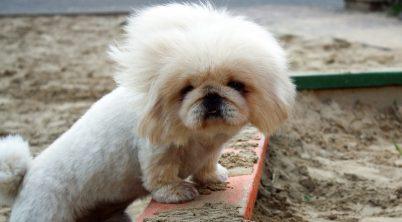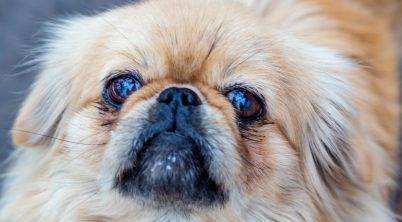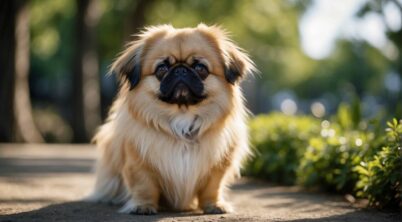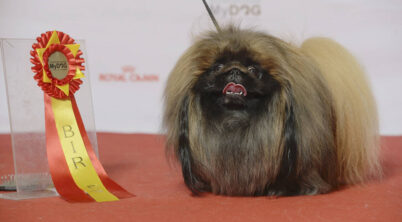The Pekingese is a dog breed with a storied history that originates from ancient China. Known for their connection with Chinese royalty, these dogs were once companions to emperors and members of the imperial family. Their distinctive appearance, with a flat face, large eyes, and luxurious mane, not only reflects their noble heritage but also some of the breed’s distinctive physical traits that are relevant to their health and behavior today.
One particularly unique aspect of the Pekingese is their walk, which is often described as a rolling gait. This breed-specific movement is a result of their physical build, but it can occasionally be impacted by various health issues that the Pekingese are prone to. Given their brachycephalic (flat-faced) nature, these dogs may experience difficulties with respiration, and their large, prominent eyes are susceptible to a variety of problems.
Understanding the Pekingese’s needs begins with recognizing their history and physical characteristics. From the silken laps of Chinese nobility to the homes of dog lovers around the world, the Pekingese has always been a breed that combines elegance with a certain level of vulnerability. This vulnerability can sometimes manifest in a reluctance or inability to walk, which may be a cause for concern for owners. It is essential to consider their overall well-being, as their rich heritage carries with it the responsibility to provide a lifestyle that accommodates their unique needs.
Table of Contents
Pekingese Not Walking
When a Pekingese is reluctant to walk, it may indicate various concerns that require attention. Initially, it’s essential to assess the health and well-being of the dog, as reluctance to walk could stem from physical discomfort or illness.
Common Physical Ailments:
- Joint issues: Pekingese are prone to joint problems like patellar luxation.
- Respiratory issues: Due to their flat faces, they may experience brachycephalic syndrome, leading to breathing difficulties, especially under exertion.
- Obesity: A common issue with Pekingese; excess weight can make walking unpleasant.
If physical problems are ruled out, consider the psychological aspects. Behavioral issues could also be a reason for a Pekingese’s unwillingness to walk.
Behavioral Considerations:
- Anxiety or Fear: May result in a reluctance to venture outdoors.
- Leash Reactivity: Some Pekingese may resist walking when they feel the confines or the pressure of a leash.
Providing positive reinforcement can be effective in encouraging the Pekingese to walk. Engaging in consistent and patient training is also crucial for overcoming fear or reactivity issues. It’s essential to:
- Use gentle encouragement with treats and praises.
- Gradually increase exposure to walking environments.
- Maintain consistency in walking routines.
In conclusion, a Pekingese not walking necessitates a review of both health and behavior to identify the cause. If the issue persists, it is advisable to consult with a veterinarian or a professional dog trainer for targeted advice and intervention.
Understanding Pekingese Temperament
The Pekingese possesses a distinct temperament characterized by its loyalty and affection towards its family, yet is underpinned by a notable stubbornness and desire for independence. Understanding these aspects is fundamental when considering their behavior and interactions with their owners.
Loyalty and Affection
The Pekingese is profoundly loyal to its family, often forming a strong bond that is both protective and loving. They exhibit high levels of affection, particularly towards the individuals they consider part of their pack. This breed is known for:
- Being extremely friendly towards its owners.
- Providing comfort and companionship, thriving on close human interaction.
- Displaying a loving nature that extends well to families with children, given proper socialization.
Stubbornness and Independence
While Pekingese are affectionate, they are also marked by a stubborn streak:
- They value their autonomy, exhibiting an independent spirit that can sometimes make training a challenge.
- This stubbornness necessitates a consistent and patient approach to obedience training.
- Their independence means they do not necessarily require constant attention to stay content. However, they are not suited to being left alone for prolonged periods.
The Pekingese is a breed that balances its endearing devotion to its family with a clear sense of self-sufficiency.
Common Health Issues in Pekingese
Pekingese dogs are prone to certain health issues that are important for owners to be aware of. Recognizing symptoms early can facilitate prompt veterinary attention, which may prevent complications.
Brachycephalic Health Concerns
Pekingese are a brachycephalic breed, meaning they have a short muzzle and a flat face. This anatomy can lead to:
- Breathing problems: Struggles with the respiratory system are common, due to narrowed nostrils and elongated soft palate.
- Heat intolerance: Difficulty regulating temperature may result in overheating.
Eye Conditions
The distinctive eye structure of Pekingese raises several health concerns, including:
- Corneal ulcers: Their prominent eyes are susceptible to scratches leading to ulcers.
- Dry eye: A condition characterized by inadequate tear production.
- Cherry eye: Protrusion of the third eyelid gland which can appear as a red mass.
- Progressive retinal atrophy: A degenerative disease affecting the retina which can lead to blindness.
Orthopedic Conditions
Pekingese may suffer from orthopedic issues due to their physique:
- Patellar luxation: A dislocation of the kneecap that can cause lameness or abnormal walking patterns.
- Intervertebral disk disease: Can result in pain, paralysis, or arthritis.
- Arthritis: Often affects older dogs and can be exacerbated by obesity.
Other Notable Health Problems
Other health issues can also affect the well-being of Pekingese:
- Dental disease: Their teeth are prone to overcrowding, leading to dental problems.
- Obesity: Excess weight can exacerbate breathing and orthopedic issues.
- Heart disease: Like many small breeds, Pekingese may be predisposed to cardiac conditions.
- Ear infections and Allergies: These can be recurrent issues for Pekingese, often needing veterinary supervision.
Exercise and Activity Needs
Pekingese dogs require a balanced approach to exercise and activity. Due to their small size and short legs, they don’t need extensive physical activity but should engage in regular exercise for their mental health and to maintain a healthy weight.
Suitable Activities for Pekingese
- Indoor Play:
- Fetch: Involves throwing a small ball or toy for the dog to retrieve.
- Hide and Seek: Encourages mental stimulation while providing some physical activity.
- Outdoor Exercise:
- Moderate Walks: Two 20-minute walks each day are beneficial.
- Dog Parks: Interaction with other dogs offers social stimulation and activity.
- Structured Activities:
- Obedience Trials: These not only exercise the body but also engage the dog’s mind.
- Toys: Having a variety of toys can keep them active and prevent boredom indoors.
Risks of Over-exercising
- Breathing Difficulties: Pekingese are brachycephalic, meaning they have flat faces and can struggle with breathing when overexerted.
- Joint Stress: Excessive exercise can put undue stress on their short limbs leading to joint issues.
- Heat Sensitivity: They are prone to overheating due to their thick coats and facial structure, so it’s essential to monitor them during exercise, especially in warm weather.
Grooming and Maintenance
The grooming and maintenance of a Pekingese are critical for its well-being, with specific attention needed for coat care, dental hygiene, and the proper upkeep of nails and ears.
Coat Care
A Pekingese’s coat is one of its most defining features, often coming in colors like black, white, or parti-color. Regular grooming is essential to maintain the structure and appearance of their luxurious coat. Daily brushing is recommended to prevent matting and to keep the fur clean and free from debris. Specifically, the long, flowing coat that covers their body, especially the lion-like mane around the head and shoulders, requires careful attention. During grooming:
- Use a bristle brush for the outer coat to ensure luster.
- Employ a metal comb to work through tangles in the undercoat.
- Follow a regular schedule, as consistent grooming prevents severe matting that can lead to skin issues.
Dental Care
A Pekingese requires routine dental care to maintain overall health. Dental issues can lead to more serious health concerns if not addressed. To ensure proper oral hygiene:
- Brush their teeth several times a week using a dog-specific toothbrush and toothpaste.
- Regularly check for signs of dental problems, such as bad breath, swollen gums, or loose teeth.
Nail and Ear Maintenance
Ignoring a Pekingese’s nails and ears can lead to discomfort and infections. Maintaining these areas is critical. For proper nail and ear care:
- Trim nails regularly to prevent overgrowth which can affect their gait and comfort.
- Clean the ears with a gentle ear cleaner to avoid a buildup of wax and debris, which can result in infections.
- Always inspect the ears for signs of redness or a bad odor, which often indicate an issue that may require a vet’s attention.
By adhering to these grooming and maintenance routines, a Pekingese’s health and regal appearance can be upheld.
Training and Socialization
Proper training and socialization are crucial for a Pekingese’s well-being. They establish acceptable behavior and enhance the dog’s sociability, affecting both its gait and temperament in various environments.
Basic Training Techniques
When training a Pekingese, it is important to begin with simplicity and consistency. Owners should focus on fundamental commands such as sit, stay, and come. To ensure the Pekingese understands these commands, one should incorporate the following steps:
- Use clear, consistent commands: Always use the same words and tone to avoid confusion.
- Reward good behavior: Positive reinforcement with treats or praise encourages the Pekingese to repeat the desired behavior.
- Maintain a regular schedule: Consistent training sessions help the Pekingese learn what is expected of them.
- Exercise patience: As a breed, Pekingese can have a stubborn streak, so patience is key.
Training should never be mean-spirited or punitive, as this can lead to behavioral issues. Instead, one should aim for a balance of firmness and kindness to garner the best response from the Pekingese.
Socializing Your Pekingese
Socialization is the process of exposing the Pekingese to a variety of people, animals, and environments to promote a well-adjusted temperament. Here’s how to effectively socialize your Pekingese:
- Start early: The earlier a Pekingese is socialized, the more likely they are to be comfortable in different situations.
- Introduce new experiences gradually: Too much too soon can be overwhelming. Start with calm, controlled introductions to new people and animals.
- Frequent, short outings: Short trips to different places can help the Pekingese adapt to various scenarios.
- Monitor body language: A relaxed gait and demeanor mean the dog is comfortable, while a stiff posture may indicate discomfort.
Socialization requires attention to the Pekingese’s cues and responds accordingly. Proper socialization helps to prevent reactive behaviors, ensuring the Pekingese is well-behaved both at home and in public.
Feeding and Nutrition
Proper feeding and nutrition are critical for maintaining a healthy weight and preventing obesity in Pekingese dogs. Their unique body composition and size require a well-balanced diet to support their overall health.
Choosing the Right Diet
When selecting food for a Pekingese, it’s important to choose a diet that aligns with their caloric needs to prevent overweight and obesity issues. Dry dog food is recommended at about 1/2 to 1 cup per day, divided into two meals. The specific amount will depend on the dog’s age, size, and activity level. Here is a brief guide:
- Puppy (under 1 year): Opt for high-quality puppy formula that supports growth.
- Adult (1-7 years): A balanced adult dog food that maintains weight and supports activity.
- Senior (7+ years): Introduce senior dog food that caters to a slowing metabolism.
Understanding Pekingese Nutritional Needs
A Pekingese dog’s diet should address its slower metabolism and the breed’s tendency for weight gain. Here are key nutritional considerations:
- High-quality protein: To maintain muscle mass and body condition.
- Low-calorie density: To avoid excess weight gain which can lead to obesity.
- Adequate fiber: For digestive health and to promote satiety.
- Essential fatty acids: For healthy skin and coat, especially considering their thick mane.
Regular evaluations of the dog’s weight and body condition are essential to tailor their diet and prevent obesity, which is a common health concern in Pekingese. Adjustments to the diet should be made based on these regular assessments.
Pekingese and Family Life
The Pekingese breed, known for its affection and loyalty, is a suitable choice for families seeking a companion animal. This dog’s temperament makes it a well-loved member of the household, though its interaction with children and other pets warrants a cautious approach.
Interacting with Children and Other Pets
Pekingese dogs can be affectionate with children, but supervision is key due to their small size and potential for injury if handled roughly. It’s important to teach children how to interact gently with Pekingese dogs to foster positive relationships. Consistent, positive interaction helps reinforce the bond between the dog and young family members.
When it comes to other household pets, Pekingese may show a variable temperament. Early socialization is imperative to encourage a harmonious coexistence. They can enjoy the company of other pets, especially when raised together, but they may not tolerate rough play from larger animals due to their small stature and self-important nature.
Pekingese as Companion Animals
Pekingese have long been valued for their companionship. Their small size makes them ideal for living in smaller spaces, and they don’t require extensive exercise, which aligns well with less active family lifestyles. A Pekingese’s loyalty and affectionate nature make it an excellent companion, particularly for the elderly or those living alone. As companion animals, they offer comfort and are often content with being close to their family members.
Despite their toy breed status, Pekingese can be independent and sometimes even aloof. Their personality is such that they will seek affection on their own terms, often blossoming in a calm and stable household environment. With consistent, gentle interaction, they integrate well into the family dynamic, serving as a devoted and regal presence within the home.
Special Considerations for Pekingese Care
When caring for Pekingese, it is crucial to understand their unique physical characteristics and health predispositions. This understanding will help in creating a suitable environment and in staying vigilant about their health needs.
Managing Your Pekingese’s Environment
Pekingese, with their flat faces and broad chest, are a small Chinese breed with a rich history dating back to the lion dogs of ancient China. They are a toy breed that thrived in the Chinese Imperial palaces. This breed’s distinctive flattened face can lead to breathing difficulties, making it imperative to maintain a cool, well-ventilated environment, especially during warm weather to prevent heat stroke.
- Avoid excessive heat: Provide an indoor space with air conditioning or fans during hot weather.
- Exercise: Moderate exercise is essential, but avoid strenuous activity.
- Surface: Be mindful of the type of flooring; Pekingese have delicate feet that benefit from soft, non-slip surfaces.
Health Monitoring and Vet Visits
The Pekingese’s luxurious coat and unique anatomical features can lead to specific health concerns. The breed is prone to eye problems due to its large, prominent eyes and shallow eye sockets. Eye disease, along with potential mitral valve disease, means regular health check-ups are vital for early detection and management.
- Eye Care: Regularly check their eyes for signs of irritation or infection. Clean their lips and skin folds to prevent infections.
- Veterinary Care: Schedule regular vet visits for early detection and management of diseases.
- Health Screening: Tests for detecting early signs of heart issues and other breed-specific conditions are recommended.
By taking these considerations into account, Pekingese owners can ensure a higher quality of life for their pets, keeping them comfortable and healthy for years to come.

